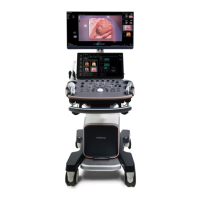Image Optimization 5-143
Note
RIMT inside ROI is highlighted in red, yellow and green. There is no gap between the
filling area and the vascular wall.
The green color indicates the normal acceptable value.
The red color or yellow color indicates the abnormal unacceptable value.
4. Tap [Start Calc] to measure RIMT of left carotid and right carotid. Six RIMT values (each RIMT
value represents maximum IMT value within one cardiac cycle), RIMT average value (arithmetic
mean value of the 6 RIMT values), SD (standard deviation of the 6 RIMT values) and ROI length
are displayed in the result window.
5. Tap [Accept Result] or press <Set>. The image is frozen. You may save single frame image and
results of the result window.
Tap [ReCalc] to recalculate RIMT.
6. Tap [Report] to view the report. Only last acceptable data, including RIMT on left and right carotid,
is in the data sheet. You can perform:
Deleting data: select RIMT data from the data sheet. Tap [Delete Rows] to remove the RIMT
data of the left and the right carotid.
Viewing graphic: tap [IMT Trend] to view the RIMT graphic. The data on the graphic is same
with these in data list. The RIMT average value, SD and ROI length of the exams are
displayed at the bottom of the graphic (including the current exam).
Previewing the report: tap [Preview] to show IMT. The RIMT average value, SD and ROI length
of the exams are displayed.
See Advanced Volume for setting, printing, saving or loading the report.
7. Tap again [RIMT] to exit.
5.19 R-VQS
R-VQS (RF-data based quantification on arterial stiffness) tracks movements of the upper and lower
vessel walls and measures vessel diameter, displacement, coefficient of hardness and PWV
(dimensionless pulse wave velocity).
Hardness coefficient: Arterial stiffness is changed with the blood pressure changing. The bigger the
value the higher the stiffness.
PWV (dimensionless pulse wave velocity) represents the transmit speed of pulse wave. The bigger the
stiffness parameter the higher the PWV.
NOTE:
Vascular Package should be configured.
R-VQS is an option.
Basic Procedures
1. Select a probe and carotid exam mode. Perform B real-time imaging and search for carotid vessel.
Try to place the vessel on the image horizontally.
2. Tap [R-VQS] and roll the trackball to locate green ROI box on the target area. Dotted line of the
ROI lies in the middle of the vessel and divides the vessel upper wall and lower wall. Use <Set>
and trackball to change ROI size and position. Note that ROI should include the upper and lower
wall of the vessel.

